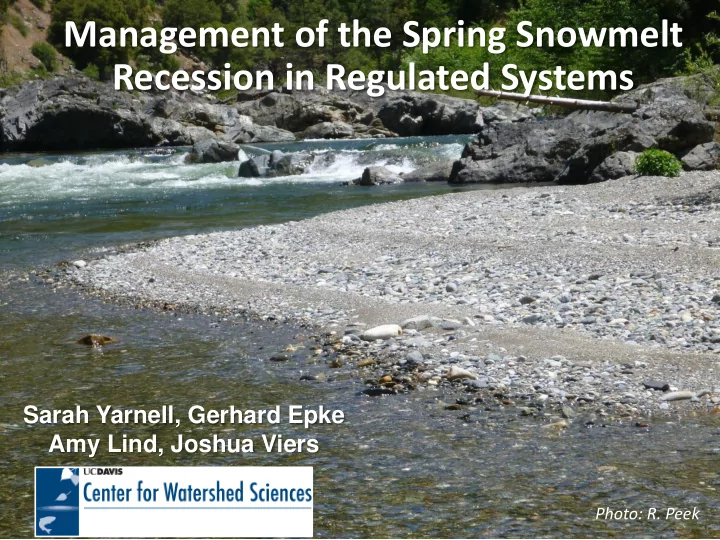

Management of the Spring Snowmelt Recession in Regulated Systems Sarah Yarnell, Gerhard Epke Amy Lind, Joshua Viers Photo: R. Peek
Spring Snowmelt Recession Ecology • The one time annually where high resources are coupled with predictable flows • Results in high biodiversity (Gasith & Resh 1999) Yarnell, S.M., J.H. Viers and J.F. Mount. 2010. BioScience 60:114-127.
Regulated Flow Regimes Yuba Rivers - WY 2011 NF Yuba MF Yuba SF Yuba 7000 6000 Discharge (cfs) 5000 4000 3000 2000 1000 0 1-Oct 31-Dec 1-Apr 1-Jul 30-Sep
Quantifying the Flow Recession Yarnell et al., 2010
Quantifying the Spring Recession Rate: Unregulated Basins in the Sierra Nevada Indian Creek/Feather River North Fork Yuba River North Fork American River Cosumnes River Clavey River Merced River Daily recession rates are South Fork Kaweah River consistent across basins and elevations Kern River N Epke, G. 2011
Daily Percent Change in Discharge Daily recession rates: 1) decrease during the recession (on average from 8 to 4%), 2) are limited (typically < 20%)
Calculating a Spring Recession Flow Regime Yuba Rivers - WY 2011 Requires knowledge of: NF Yuba MF Yuba SF Yuba 7000 6000 Discharge (cfs) 5000 • hydrology of the regulated river 4000 3000 2000 • hydrology of an analogous 1000 0 1-Oct 31-Dec 1-Apr 1-Jul 30-Sep unregulated river • limitations of the regulated system infrastructure • hydraulic-related thresholds for aquatic species of interest (e.g. maximum allowable ramping rates) • representative channel morphology of the regulated river
Rubicon River Example • Regulated bypass reach below high-elevation reservoir • Regulated flows dominated by spring spills and baseflow • Unregulated NF American in same watershed Use 2D hydrodynamic model to evaluate flow effects on native species
Rubicon River Example Rubicon River 800 • Start the recession calculated recession 600 Flow CFS proposed flows from spill at 700 cfs 400 when gain control of 200 the system 0 1-Jun 11-Jun 21-Jun 1-Jul Date • Decrease flows at rates Calculated Recession Flows Flow Schedule similar to the natural Day Flow Step % change Flow Step % change rates (8-5%/day) 1 700 -- 700 -- 2 644 0.080 600 0.143 • Limit steps to 3 594 0.079 600 0.000 <20%/day 4 547 0.078 600 0.000 5 466 0.077 500 0.167 • Reach the minimum … … … … … instream flow within 42 40 0.052 40 0.000 43 38 0.051 35 0.125 45 days 44 36 0.051 35 0.000 45 35 0.050 35 0.000
Modeled Flow Recession Scenarios Recession Ramp-down Scenarios Four Scenarios: 8% - 5% 9.5% 15% 30% Baseflow - 30 cfs Average Spring 800 Rate = 8%-4% 700 Constant Low = 600 Flow (cfs) 9.5% 500 400 Constant 300 Medium = 15% 200 Maximum 100 Observed in 0 0 7 14 21 28 35 42 Nature = 30% Day
Foothill Yellow-legged Frog Breeding Habitat • Frogs lay egg masses in very low velocity locations at 20-40 cm depth • 3 weeks required for egg masses to hatch and (Bondi C.B., S.M. Yarnell and A.J. Lind. 2013.) tadpoles to grow big enough to follow receding water’s edge • → Flow recession of 10 cm per week will limit desiccation of eggs
Spatial Niche Analysis p y 2 Depth and velocity Trout Fry 1.8 Juv RBT guilds for aquatic Deep/Fast Deep/Slow Deep/Medium Adt RBT (Shallow 1.6 Water) species of interest Juv HH PM 1.4 in the PCWA Adt HH PM 1.2 Depth (m) Trout Spawning Middle Fork Medium/ Medium/Medium Medium/Fast Fast Adt S Sucker Slow 1 Project Juv S Sucker 0.8 FYLF Egg Mass 0.6 Example: FYLF Tadpole Cal Roach Rainbow Trout 0.4 Shallow/Fast Shallow/Medium Shallow/ Slow Sculpin / Spk Dace Spawning 0.2 Primary Niches Juvenile Hardhead Shallow 0 0 0.2 0.4 0.6 0.8 1 Velocity (m/s) Fry = Rainbow Trout, RBT = Rainbow Trout, HH = Hardhead, PM = Sacramento Pikeminnow , Spaw n = Trout Spaw ning, S = Sacramento, FYLF = Foothill Yellow -Legged Frog, Cal = California, Spk = Speckled, Juv = Juvenile, Adt = Adult
Modeled Flow Recession Scenarios Rate of Decreasing Stage (725 to 30 cfs) 45 40 35 cm / week 30 25 20 15 10 5 0 8-5% 9.5% 15% 30% Ramping Rate (% / day) FYLF eggmasses – 30 cm average depth/3 weeks to hatch
Modeled Flow Recession Scenarios Duration of Recession Native Species 725 cfs to 30 cfs Ramping Rate (%/day) Emergence 30% 15% 9.5% 8-5% 0 10 20 30 40 50 Days FYLF – 3 weeks; Native spring spawning fish – 2-4 weeks
Spatial Niche Analysis Spatial Niche Distribution Percent of modeled nodes 60 725 425 220 77 32 within each spatial niche at 50 each of five modeled 40 Percent discharges (725 cfs – 32 cfs). 30 20 10 0 Spatial Niche Diversity 7 Simpson's Diversity Index 6 5 Simpson’s Diversity Index 4 3 calculated from the distribution 2 of spatial niches at each of five 1 0 modeled discharges 725 425 220 77 32 Modeled Discharge (cfs)
Implications for Regulated Systems • Restoration of the spring recession achievable by modeling rates of change to increase hydraulic habitat diversity • Hydraulic diversity in both space and time is necessary to support the full complement of native aquatic species • Key to diverse hydraulic habitat mosaic is to shift relatively slowly through time – allow for development of eggs and larvae within a spatial niche before the niche disappears
Application in Regulated Systems Recession rates can be modeled as down-ramping rates from spill or an ecological flow pulse Examples in California: USFS PM&E Spill Cessation Flow – South Fork Yuba River 300 – South Fork San Joaquin River 250 Flow (CFS) – McCloud River 200 – North Fork Feather Cresta Reach 150 100 – Middle Fork American River 50 – Upper Yuba Rivers 0 1-Jun 6-Jun 11-Jun 16-Jun 21-Jun 26-Jun 1-Jul
Acknowledgements • Funding: California Energy Commission • Collaborators: US Forest Service, Placer County Water Agency, Ryan Peek, Craig Addley Tuolumne River
Recommend
More recommend